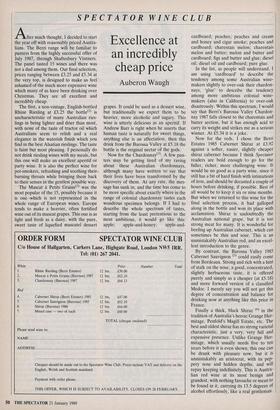SPECTATOR WINE CLUB
Excellence at an incredibly cheap price
Auberon Waugh
After much thought, I decided to start the year off with reasonably priced Austra- lians. The Berri range will be familiar to punters from the highly successful offer of July 1987, through Shaftesbury Vintners. The panel tasted 15 wines and there was not a dud among them. Our final selection, prices ranging between £3.25 and £5.34 at the very top, is designed to make us feel ashamed of the much more expensive wine which many of us have been drinking over Christmas. They are all excellent and incredibly cheap.
The first, a non-vintage, English-bottled Rhine Riesling at £3.25 the bottle(1) is uncharacteristic of many Australian ries- lings in being lighter and drier than most, with none of the taste of tractor oil which Australians seem to relish and a real elegance in the waterish finish which you find in the best Alsatian rieslings. The taste is faint but most pleasing. I personally do not drink riesling wines with my meals, but this one will make an excellent aperitif or party wine. It is also the perfect wine for pot-smokers, refreshing and soothing their. burning throats while bringing them back to their senses in the gentlest possible way. The Muscat a Petits Grains(2) was the most popular of the 15, possibly because it is one , which is not represented in the whole range of European wines. Europe tends to make a heavier, often fortified wine out of its muscat grapes. This one is as light and fresh as a daisy, with the pure, sweet taste of liquefied muscatel dessert
grapes. It could be used as a dessert wine, but traditionally we expect them to be heavier, more alcoholic and sugary. This wine is utterly delicious as an aperitif. If Andrew Barr is right when he asserts that human taste is naturally for sweet things, anything else is an affectation, then this drink from the Barossa Valley at £5.18 the bottle is the original nectar of the gods.
Now for the Chardonnay(3). A few pun- ters may be getting tired of my raving about these Australian chardonnays, although many have written to say that their lives have been transformed by the discovery of them. At any rate, the mes- sage has sunk in, and the time has come to be more specific about exactly where in the range of colonial chardonnay tastes each wondrous specimen belongs. If I had to describe the whole spectrum of tastes, starting from the least pretentious to the most ambitious, it would go like this: apple; apple-and-honey; apple-and- cardboard; peaches; peaches and cream and honey and cigar smoke; peaches and cardboard; charentais melon; charentais melon and butter; melon and butter and cardboard; figs and butter and glue; diesel oil; diesel oil and cardboard; pure glue.
In the list, as people will understand, I am using 'cardboard' to describe the tendency among some Australian wine- makers slightly to over-oak their chardon- nays, 'glue' to describe the tendency among more ambitious colonial wine- makers (also in California) to over-oak disastrously. Within this spectrum, I would say that Bern's Barossa Valley Chardon- nay 1987 falls closest to the charentais and butter section, but it has enough acid to carry its weight and strikes me as a serious winner. At £5.34 it is a joke.
Now for the reds. I chose the Berri Estates 1985 Cabernet Shiraz at £3.92 against a softer, easier, slightly cheaper shiraz cabernet because I think Spectator readers are bold enough to go for the fuller, richer, more challenging wine. It would be no good as a party wine, since it still has a bit of hard finish with intimations of iron, and should be decanted a couple of hours before drinking, if possible. Best of all would be to keep it six or nine months. But when we returned to this wine for the final selection process, it had galloped along in the bottle and won its place with acclamation. Shiraz is undoubtedly the Australian national grape, but it is too strong meat for many. It is wonderful for beefing up Australian cabernet, which can sometimes be thin and sour. This is an unmistakably Australian red, and an excel- lent introduction to the genre.
By contrast, the Barossa Valley 1985 Cabernet Sauvignon (5) could easily come from Bordeaux. Strong and rich with a hint of stalk on the nose, a good, concentrated, slightly herbaceous taste, it is offered purely and simply as a cheaper (at £5.18) and more forward version of a classified Medoc. I merely say you will not get this degree of concentration and balance for drinking now at anything like this price in France.
Finally a thick, black Shiraz (6) in the tradition of Australia's heroic Grange Her- mitage, Penfold's Magill Estate, etc. The best and oldest shiraz has no strong varietal characteristic, just a very, very full and expensive presence. Unlike Grange Her- mitage, which usually needs five to ten years before it is even shown, this one can be drunk with pleasure now, but it is unmistakably an aristocrat, with its pep- pery nose and hidden depths, and will repay keeping indefinitely. This is Austra- lian red wine at its most benign and grandest, with nothing farouche or mean to be found in it, carrying its 13.5 degrees of alcohol effortlessly, like a real gentleman.


























































 Previous page
Previous page